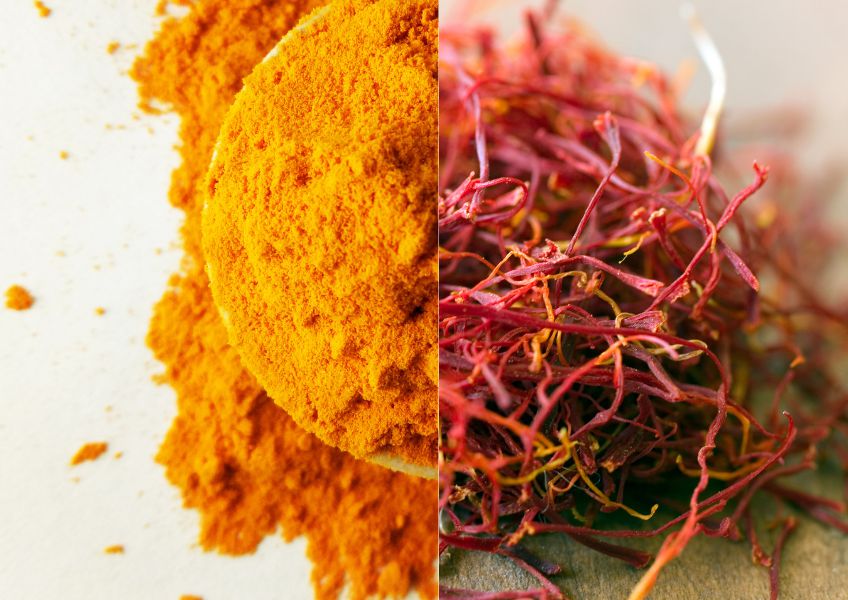Both golden-hued, vibrant, and widely celebrated, Turmeric and Saffron are two powerhouses in the world of culinary delights and medicinal wonders. While they share some similarities, their origins, health benefits, and applications set them apart. Keep reading to discover which of these legendary spices deserves the title of the ultimate golden spice.
Origins And Historical Significance: Turmeric vs Saffron
Turmeric: This root got its name from the Latin “terra merita” which means meritorious earth (1), and this herb certainly has many virtues. Native to Southeast Asia, Turmeric comes from the root of the plant Curcuma longa and has been a cornerstone of traditional Ayurvedic medicine for thousands of years. Revered for its deep golden hue and earthy flavor, it’s often referred to as the “golden spice” and has found its way into countless dishes and medicinal preparations.
Saffron: Saffron, the red-gold treasure, originates from the Crocus sativus flower, which is native to the Mediterranean area and Southwest Asia (2). Harvesting saffron is labor-intensive, requiring the hand-picking and drying of the flower’s delicate stigmas (the parts that produce pollen). This makes it one of the world’s most expensive spices by weight. Like Turmeric, Saffron has been celebrated since ancient times, not just for its culinary uses but also for its potential therapeutic properties.
Turmeric vs Saffron: Benefits
Turmeric:
- Contains curcumin, a potent antioxidant and anti-inflammatory compound (3).
- Helps to support digestive health (3).
- May support brain function and reduce the risk of heart diseases (4,5).
- Can alleviate symptoms of arthritis and depression (3).
- May support the liver and detoxification (6).
>>>Read testimonials by people who have experienced the benefits of a Turmeric supplement!
Saffron:
- Rich in safranal, crocin, and other antioxidants that fight oxidative stress(7,8).
- May help improve mood and treat depressive symptoms (9).
- Known to reduce appetite and assist in weight loss (10).
- Boosts memory and may protect against age-related diseases (11).
📣 Good News! Approved Science® Saffron with BioPerine® is now available!
Similarities And Differences:
- Color & Form: While both spices offer rich, distinctive colors, Turmeric is more golden-yellow and Saffron is more red to deep orange. Turmeric is usually found in powdered form, whereas saffron is recognized by its fine, thread-like stigmas.
- Source: Turmeric comes from the root of the curcuma longa while Saffron comes from the Crocus sativus flower.
- Application: Both are staples in various cuisines and considered to be popular supplements. They both provide antioxidant and mood-boosting properties in addition to other benefits, however, Turmeric is mainly taken for inflammation whereas Saffron is mainly taken for its effects on mood.
- Dosage: Turmeric supplements generally provide large doses of the spice with some providing 1500 mg of Turmeric. On the other hand, Saffron supplements typically contain around 30 mg of Saffron, which is a much smaller dosage that speaks volumes to the power this spice packs into each milligram.
Conclusion:
In the grand debate of “Turmeric vs Saffron,” it’s hard to declare a clear winner. While Turmeric is deemed “the Golden Spice” and Saffron is more expensive per gram than gold, they’re both highly beneficial spices. Both spices bring unique flavors, colors, and health benefits to the table. Whether you’re looking to boost your overall health, elevate your dishes, or simply explore the world of spices, both Turmeric and Saffron can be worthy additions to your diet.
Interested in reading more about Turmeric? Check out our posts on the Health Benefits Of Turmeric Curcumin With BioPerine®, the Best Time Of The Day To Take Turmeric, and Turmeric Side Effects.

